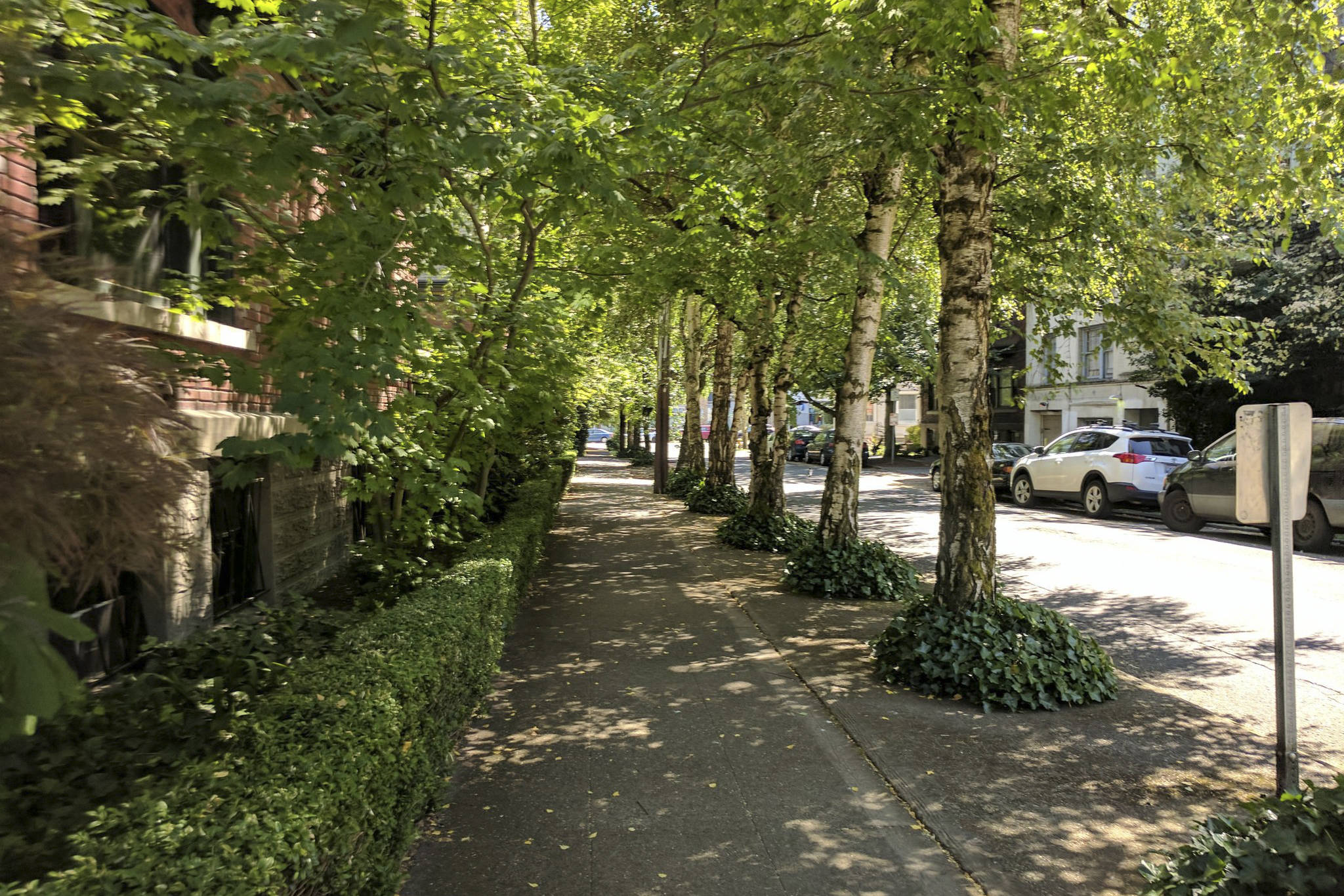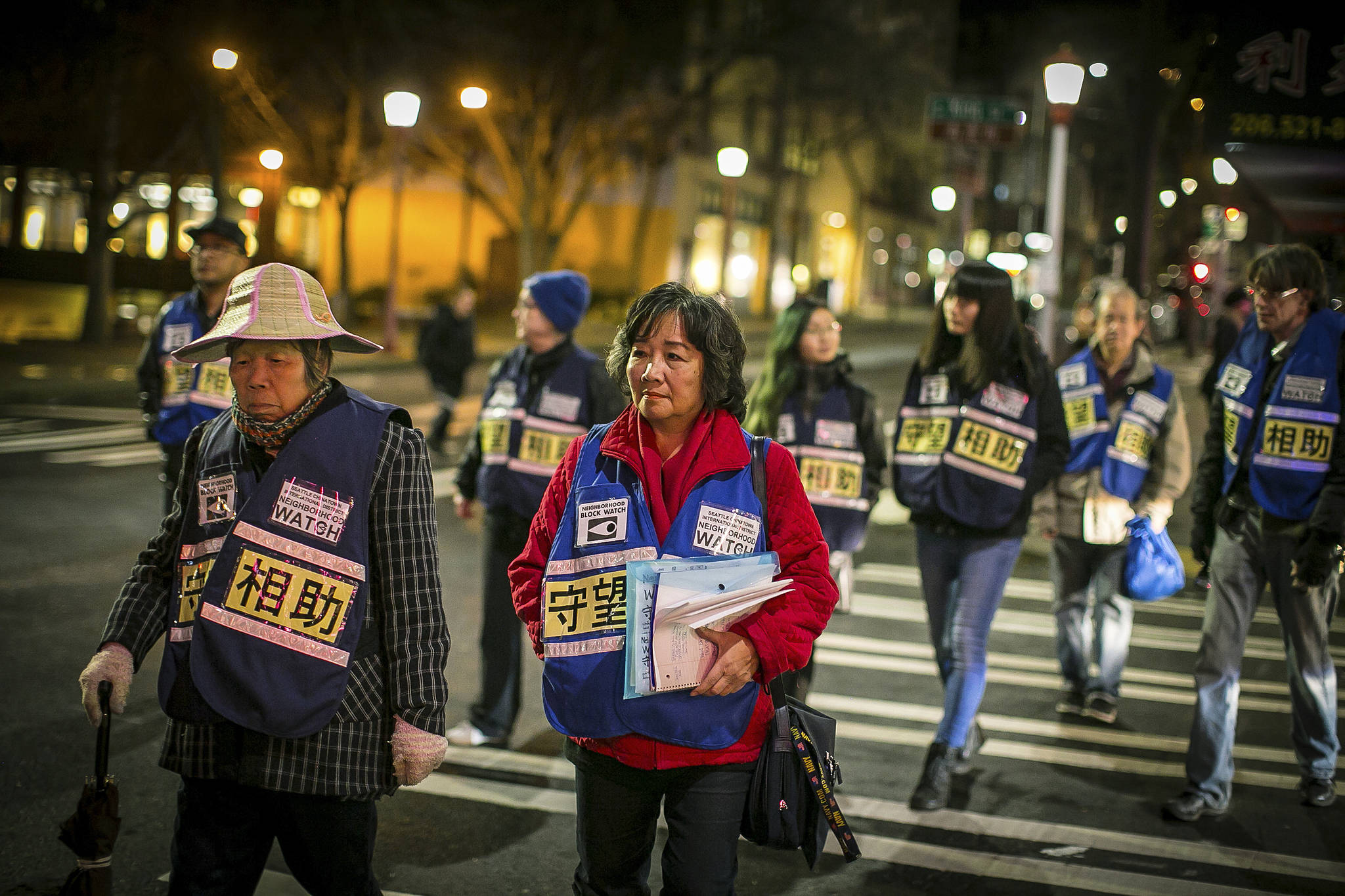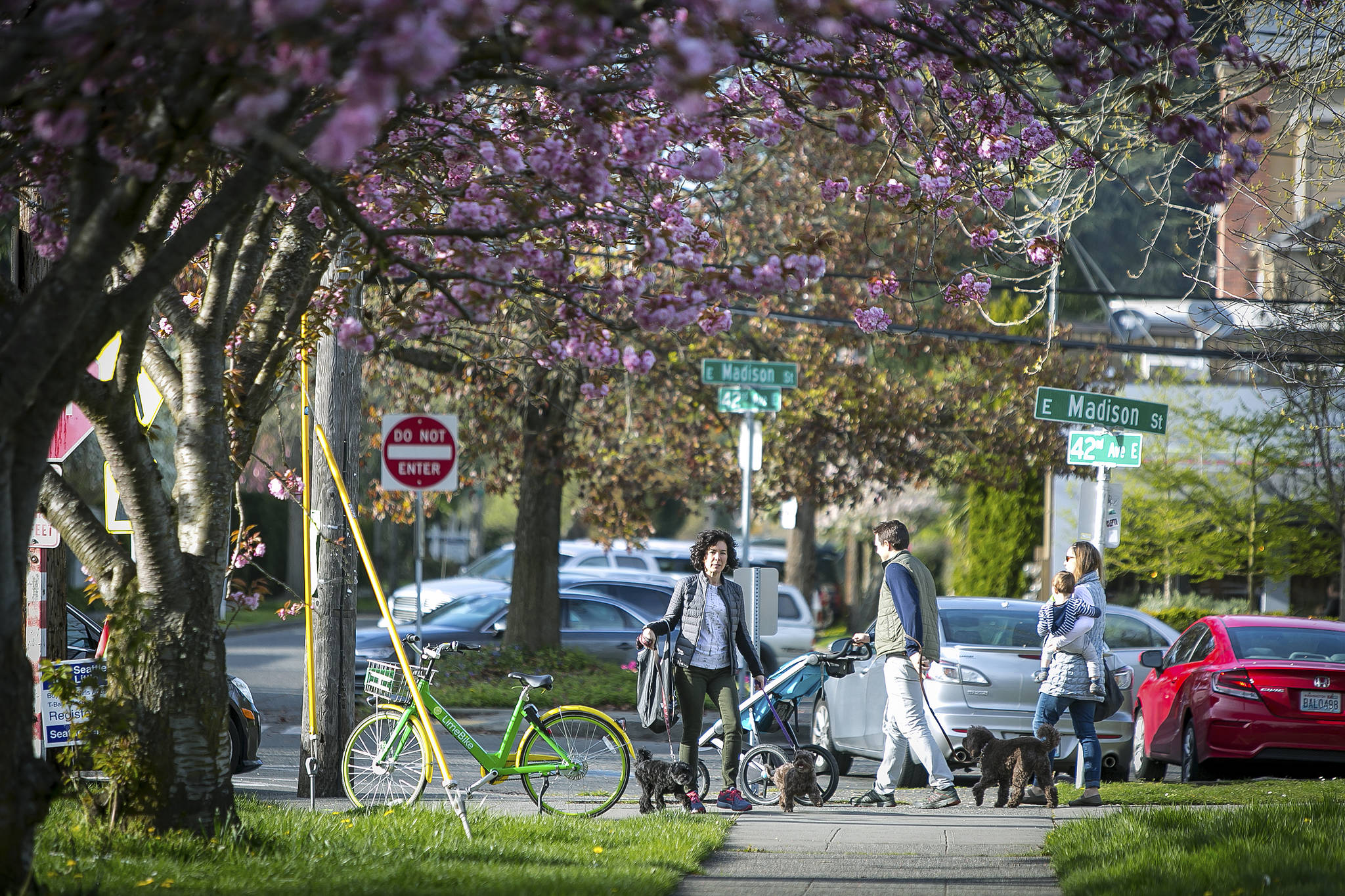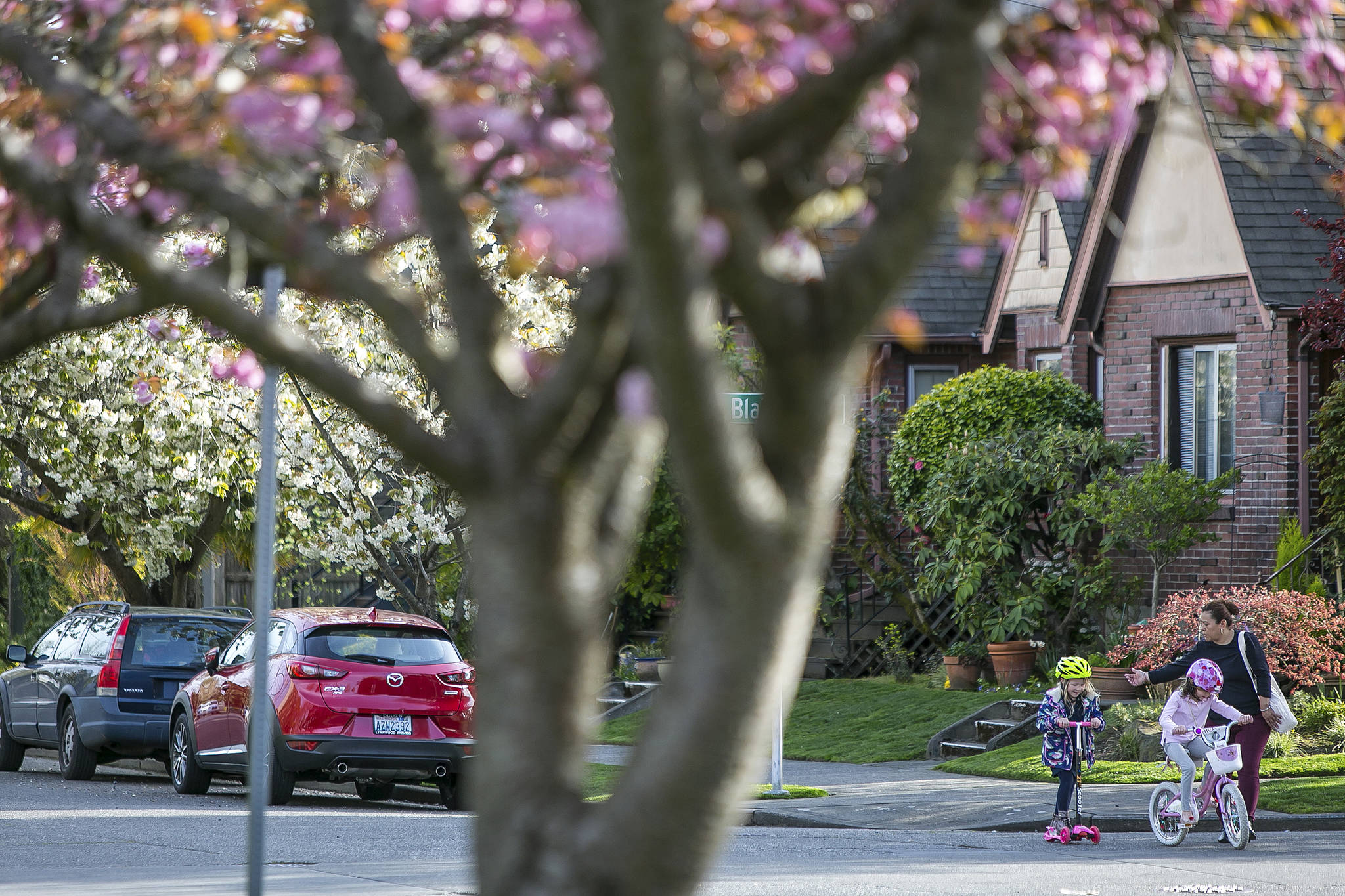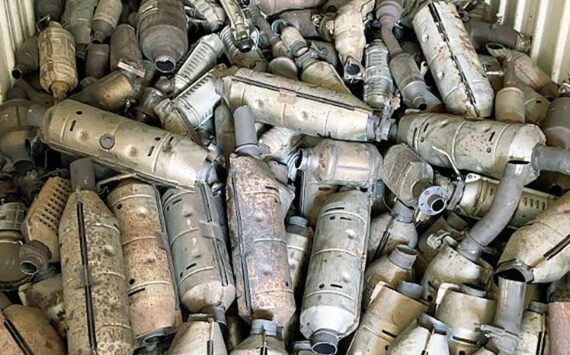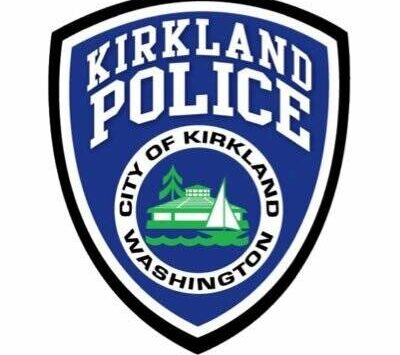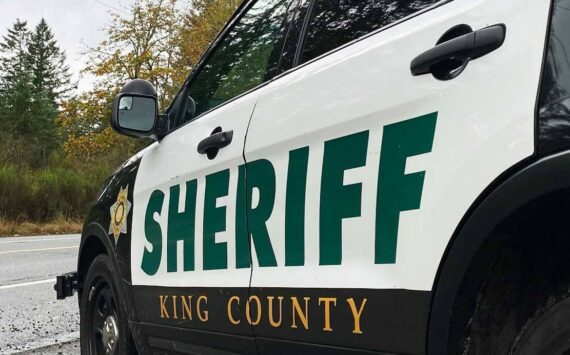Clad in bright-blue polyester vests emblazoned with Chinese characters, the Chinatown-International District Block Watch volunteers spend a Tuesday evening canvassing the neighborhood’s low slopes on the lookout for signs of trouble. On this night, the most notable incident is a barking dog in a dark car. But sometimes it’s something more sinister.
“Around here, you have to be careful,” one volunteer remarked as the group made its way down South Jackson Street, passing a shattered convenience-store window. “There’s a lot of arrests right in here for public intoxication, but it’s [also] violence, sometimes drugs.”
At least three stabbings have occurred at that corner in the past three years. Across the neighborhood populated heavily by elderly Asian Americans, rates of homicide and other violent crimes are some of the highest in the county. Low income and substandard health also plague the area. The average lifespan is seven years shorter than in King County’s affluent communities. Residents have some of the highest rates in the county of mental distress, high cholesterol, high blood pressure, diabetes, and preventable hospitalizations.
Crime. Poverty. Poor health. These issues have as many potential causes as they do consequences, but one surprising factor is often left out of the conversation—one that links them all together: a tree canopy. Or, in the case of the Chinatown-ID, the lack of one.
The Seattle Tree Canopy Assessment, a City of Seattle study, states that white, wealthy neighborhoods are more likely to have trees lining their streets than their poor, nonwhite counterparts. Perhaps the most notable example is in Census Tract 91—Chinatown/ID—where more than 80 percent of residents are not white. Two-thirds are considered by the city to be officially poor. And tree coverage is among the lowest in the city—less than 10 percent of the area is shaded.
This discrepancy comes into sharp focus this month as Seattle City Council member Rob Johnson plans to introduce legislation to tweak the city’s decade-old tree ordinance. In part, Johnson wants to establish a system of permits and fees, paid by developers who clear a lot to build or homeowners who want to remove a troublesome tree. The fees for tree removal could help fund new tree planting in areas like the Chinatown/ID where canopy is scarce. The city should take the lead to “distribute those trees in a way that is equitable and recognizes the lack of canopy in some neighborhoods,” Johnson told the Urban Forestry Commission earlier this month.
The tree-protection ordinance passed a decade ago was advertised as an interim measure. Johnson’s forthcoming legislation and the tree canopy study’s conclusions come at a time when mountains of research from around the world are confirming the numerous benefits of trees and green spaces. According to researchers, trees could actually help your grandpa’s heart disease, your mom’s small business, your sister’s grades, your neighborhood’s crime rate, and much more.
Trees have always been a part of Seattle’s draw. After all, the city’s coniferous crown is what makes the Emerald City emerald in the first place. But the city’s 2015 launch of the Equity and Environment Initiative, a city government/community partnership meant to address issues of race and social justice, also offered an opportunity to find out how different neighborhoods fare as regards a tree canopy.
“If you consider urban trees a service, it’s logical to think that underserved communities would have fewer services,” said Sandra Pinto de Bader, the urban-forestry-policy lead staffer for Seattle’s Office of Sustainability and Environment.
The city study analyzed two factors: the percentage of people of color and the percentage of people with incomes at or below 200 percent of the poverty level. Conclusion: The poorer and less-white a neighborhood, the less likely it is to have robust tree coverage.
The Chinatown/ID’s population, for example, is more than four-fifths people of color with a median household income of $29,464, according to 2015 U.S. Census estimates. The district’s tree canopy, less than 10 percent, is less than one-fifth of the coverage in the most tree-dense area, Broadview, which boasts a canopy of 55 percent. According to census estimates, Broadview is home to an 87.5 percent white population with a median household income of $125,400.
So while the Chinatown/ID has its parking lots, stadium traffic, and low tree canopy, Broadview hosts streets thickly lined with elms, dogwoods, and at least three species of maples, as well as the greenery-filled Carkeek Park. The park alone is many times larger than the Chinatown/ID’s entire treed area.
Amid growing awareness of tree-canopy benefits for health and well-being, other urban areas, including New York City and Los Angeles, also have released reports. But Seattle is at the forefront in considering the relationship among race, income, and tree cover, according to UW social scientist Kathleen Wolf, whose website provides a comprehensive look into the multiple benefits of urban greenery.
Wolf has seen firsthand how public perception of green space has changed over the years. “Oh, aren’t trees pretty” and “Gosh, isn’t it nice to have a park in the neighborhood” summed up past sentiments, Wolf said. “Now people are knowing and seeing that it’s a necessity to have this green around us.”
That realization has spurred the emerging wellness trend of forest bathing—the practice of immersing oneself in nature, unhindered by final destinations and modern technology. While only recently popular in the U.S., the concept has been around for more than 30 years in Japan, where it originated and where it has proven to improve stress levels, blood pressure, immune function, and general health, even within mere minutes.
The studies on forest bathing are only the tip of the iceberg when it comes to the benefits of trees, according to Wolf. Decades of research from around the world establish the numerous positive impacts of green spaces, especially in urban areas, which makes the unequal tree canopy all the more significant. After all, not everyone has the resources to go forest bathing for the weekend.
“This is particularly important for communities of lower socioeconomic status, because they may be people who don’t have access to getting out to those wild, dramatic landscapes,” Wolf said. “Well, if you can’t do that, then it’s really important that you have an expression of nature in your own community.”
Studies linking nature exposure to all sorts of health benefits—better mental health, reduced diabetes symptoms, decreased rates of respiratory and heart disease, and lower mortality rates—may offer a new perspective on the state of health in areas like the Chinatown/ID, where tree canopy is low and reports of substandard health are high. Air pollution in the neighborhood is so bad that asthma, respiratory, and cardiac-related hospital visits are higher than in 99 percent of other Puget Sound neighborhoods, according to a 2016 study by InterIm CDA, a 48-year-old nonprofit organization dedicated to affordable housing and community building. This study, which also involved Public Health Seattle-King County and Swedish Hospital, aimed to identify issues affecting the neighborhood’s health and propose strategies to help.
It’s well known that trees ameliorate air pollution. But would more trees in the ID translate into fewer car prowls? Higher graduation rates? Improved food security? Curing Grandpa’s diabetes?
Research has shown that all these measures improve with more greenery. It remains unclear whether trees and shrubs actually cause those effects, or are merely associated with them. Still, with so many benefits tied to more trees, the implications of unequal tree-canopy distribution are stark.
“Communities have recognized this is really important for individual and community health to have trees, to have parks and gardens around every home, every residence,” Wolf said. “And so with that comes the realization of a sense of fairness, almost a sense of ethics, that everyone in this city should have access to these resources.”
The city’s canopy study offers quantitative backing for what advocates for communities of color have been claiming for decades: People of color are disproportionately affected by environmental impact.
The results are partially traceable to the historic practice of redlining, starting with Federal Housing Authority policies, later adopted by banks, that made it difficult or impossible for would-be homeowners to obtain mortgages and become homeowners.
“Communities where folks of color have been able to live are usually the most polluted areas … so it doesn’t surprise me that a lack of green space is part of it as well,” said Jill Mangaliman, executive director of Got Green, a grassroots environmental-justice organization based in South Seattle, and co-chair of the Community Partners Steering Committee of the city’s Equity and Environment Initiative. “People are well aware of the conditions.”
Now that the city has the results of the analysis, what is it doing differently?
Right now, not a whole lot.
Pinto de Bader, the Office of Sustainability and Environment’s urban-forest lead, said that city officials want to gather information and reach out to residents of the least-treed neighborhoods before barging into those areas and planting trees without considering the area’s culture and day-to-day living patterns. To that end, the city is adding three positions to its volunteer Urban Forestry Commission, an advisory group of experts created in 2009; the new commissioners will focus on environmental justice, public health, and community and neighborhood issues. “We need a more diverse set of voices at the table,” Pinto de Bader said.
The city also plans to work with community youth to make them understand the importance of trees. De Bader cited the Duwamish Youth Corps, whose home in the valley between Beacon Hill and West Seattle is among the least-treed swaths of the city. Most trees in the city are on private property, so the people who live in these areas have to support any canopy-enhancement plans for them to succeed.
On city-owned land, a lot of the burden of planting and maintaining trees falls to the Seattle Department of Transportation, which is responsible for road rights-of-way, medians, and other properties associated with the street system. SDOT recently conducted a survey for the street tree-management plan, which allowed for city residents to say what they thought about the city’s treatment of trees before SDOT started going into neighborhoods to take inventory and plant and maintain trees. The survey “gives a bit of a narrative of what the community is saying, what the community is concerned about in those areas,” said Darren Morgan, SDOT’s urban-forestry manager.
The city is treading lightly when it comes to increasing tree canopy in less-forested parts of town. Little direct action has been taken, Morgan said, citing what community advocates have been saying for years: Local governments must be sensitive to a community’s ideas and incorporate those into its plans. “People need to learn how to have a racial-justice lens, how to listen to the community,” said Mangaliman. “That’s the major challenge—that there are entities who try to speak for us or try to take our message and warp it … We’re not a case study.”
“Environmental work that is done without a racial analysis doesn’t take into account the actual conditions on the ground,” Mangaliman continued. “The people who are most impacted by these issues are being left out of the conversation. … That’s why there’s been such a focus on ensuring those communities have a seat at the table.”
Up the street from where the Chinatown/ID block-watch volunteers have paused to examine a broken window stands a line of cherry blossom trees—one of the neighborhood’s odes to its culture and longevity. Wolf helped plant these trees along this stretch of South Jackson Street two decades ago.
An arborist on the city’s staff questioned the community’s choice, pointing out that cherry trees need more water and nutrients—and better soil—than more typical urban street trees. Still, the neighbors wanted cherry trees, in part because it was part of a larger neighborhood sprucing-up that for the first time brought together the Chinese and Vietnamese business communities. Two decades later, flowering cherries still line Jackson Street. Some do better than others, and some have had to be replaced over time.
“The idea was we’re going to plant flowering cherry trees along Jackson Street because the flowering cherry tree is a symbol [in] a number of Asian cultures,” Wolf said. “Not a good tree choice, but that’s what the community wanted.”
This story was reported by InvestigateWest, a Seattle-based journalism studio covering the environment, public health, and government accountability in the Pacific Northwest. Robert McClure contributed to this report. Learn more about InvestigateWest at invw.org.

